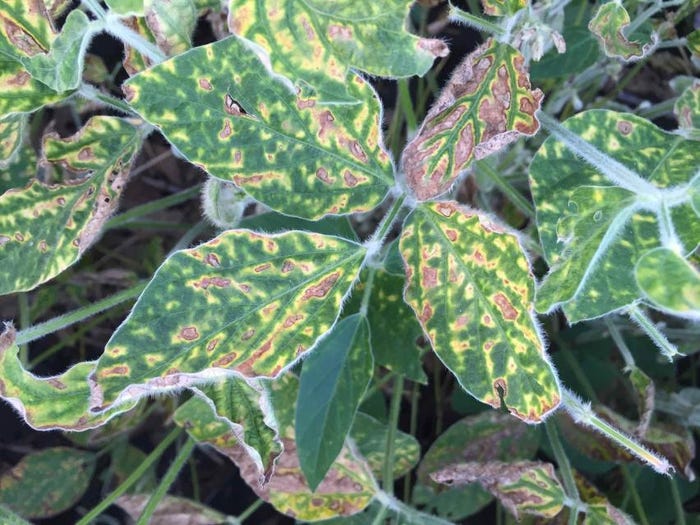October 26, 2020

The 2020 derecho left large amounts of downed corn as it swept across Iowa. Farmers faced the challenge of determining the best way to deal with this corn, which in some cases is being left in the field. Most of these fields will be planted to soybean in 2021, which brings up an interesting question – how will all the corn residue, including corn kernels, affect soybean diseases next season?
If there is increased corn residue in the field, the typical concerns about cooler, wetter soils should be considered. Cooler, wetter soils in the spring can lead to root and seedling diseases of soybean (e.g., Fusarium root rot, Pythium root rot). As a sidenote, a lot of corn residue in a field may increase the risk of certain corn diseases if planting corn on corn.
Another soybean disease that may be affected is sudden death syndrome (SDS). Corn has been shown to be an asymptomatic host, which means it can be infected by the fungus that causes SDS, but does not show symptoms. But more concerning, research from 2016 showed that the pathogen that causes SDS, Fusarium virguliforme (Fv), can actually grow on corn residue, especially the kernels (Navi and Yang, 2016). With soybean checkoff funds, the role of corn residue on SDS development was investigated in Iowa, Indiana, Michigan, Wisconsin, and Ontario, Canada from 2016 to 2018. In these studies, we explored the timing of Fv colonization of corn and soybean roots under different tillage and residue management systems. In all years, Fv levels were detected in corn roots from most fields when sampled at multiple times, with greater levels of Fv being detected in 2017. Tillage practices showed inconsistent effects on Fv root colonization and SDS foliar symptoms. Residue management did not alter root colonization of corn or soybean by Fv. In general, plots with corn residue did not differ in SDS development across site-years, although plots with corn residue did have more SDS in one location. This study did not include corn kernels, which in most years are generally not present in corn residue in large amounts as they are this year.
What does this mean for derecho-affected fields for 2021? To begin with the good, we generally did not observe corn residue affecting SDS development in our research. However, if fields have a history of SDS (Figure 1), the extra corn residue, especially with kernels, may increase the risk of SDS a few ways – it may increase the chance of getting the root rot phase of the disease (cooler, wetter soils early in the season) and may increase the amount of disease-causing inoculum in a field if the corn kernels are indeed colonized by Fv. To put this into perspective however, the role of corn residue on SDS risk is minor compared to the field history (did you have SDS in a field before?) or the weather conditions during the 2021 season.

Foliar symptoms of soybean sudden death syndrome.
Should farmers treat seed next year for SDS if there is more corn residue? Probably not. The possible greater risk of SDS caused by increased corn residue should not change your previous plans regarding SDS – in other words, if you were already going to treat with an “SDS seed treatment”, then do so. If you are on the fence, perhaps this may push you to use an “SDS seed treatment”. Keep in mind, not all the SDS seed treatments are created equally. Check out the seed treatment efficacy chart for last year’s SDS ratings and a recent Crop Protection Network article on efficacy of seed treatments for SDS, again with the support of soybean checkoff. We will be updating the efficacy chart in early 2021 when we start crunching this summer’s data. Stay tuned.
Source: Iowa State University, which is solely responsible for the information provided and is wholly owned by the source. Informa Business Media and all its subsidiaries are not responsible for any of the content contained in this information asset.
You May Also Like




